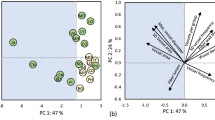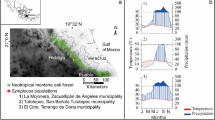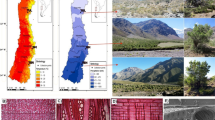Abstract
Riparian ecotones in the fynbos biome of South Africa are heavily invaded by woody invasive alien species, which are known to reduce water supply to downstream environments. To explore whether variation in species-specific functional traits pertaining to drought-tolerance exist, we investigated wood anatomical traits of key native riparian species and the invasive Acacia mearnsii across different water availability proxies. Wood density, vessel resistance against implosion, vessel lumen diameter and vessel wall thickness were measured. Wood density varied significantly between species, with A. mearnsii having denser wood at sites in rivers with high discharge. As higher wood density is indicative of increased drought tolerance and typical of drier sites, this counter-intuitive finding suggests that increased wood density was more closely related to midday water stress, than streamflow quantity per se. Wood density was positively correlated with vessel resistance against implosion. Higher wood density may also be evidence that A. mearnsii is more resistant against drought-induced cavitation than the studied native species. The observed plastic response of A. mearnsii anatomical traits to variable water availability indicates the ability of this species to persist under various environmental conditions. A possible non-causal relationship between wood anatomy and drought tolerance in these riparian systems is discussed.




Similar content being viewed by others
References
Ackerly DD (2004) Functional strategies of chaparral shrubs in relation to seasonal water deficit and disturbance. Ecol Monogr 74:25–44
Barij N, Stokes A, Bogaard T, Van Beek R (2007) Does growing on a slope affect tree xylem structure and water relations? Tree Physiol 27:757–764
Bhaskar R, Ackerly DD (2006) Ecological relevance of minimum seasonal water potentials. Physiol Plantarum 127:353–359
Chave J, Muller-Landau HC, Baker TR, Easdale TA, Ter Steege H, Webb CO (2006) Regional and phylogenetic variation of wood density across 2456 Neotropical tree species. Ecol Appl 16(6):2356–2367
Chave J, Coomes D, Jansen S, Lewis SL, Swenson NG, Zanne AE (2009) Towards a worldwide wood economics spectrum. Ecol Lett 12:351–366
Choat B, Pittermann J (2009) New insights into bordered pit structure and cavitation resistance in angiosperms and conifers. New Phytol 182:557–560
Crous CJ, Jacobs SM, Esler KJ (2012) Drought-tolerance of an invasive alien tree, Acacia mearnsii and two native competitors in fynbos riparian ecotones. Biol Invasions 14:619–631
Dawson TE, Ehleringer JR (1991) Streamside trees that do not use stream water: evidence from hydrogen isotope ratios. Nature 350:335–337
Dukes JS, Mooney HA (1999) Does global change increase the success of biological invaders? Trends Ecol Evol 14:135–139
Dye P, Jarmain C (2004) Water use by black wattle (Acacia mearnsii): implications for the link between removal of invading trees and catchment streamflow response. S Afr J Sci 100:40–44
Dye P, Moses G, Vilakazi P, Ndlela R, Royappen M (2001) Comparative water use of wattle thickets and indigenous plant communities at riparian sites in the Western Cape and Kwazulu-Natal. Water SA 27:529–538
Enright WD (2000) The effect of terrestrial invasive alien plants on water scarcity in South Africa. Phys Chem Earth Part B 25(3):237–242
Funk JL (2008) Differences in plasticity between invasive and native plants from a low resource environment. J Ecol 96:1162–1173
Galatowitsch S, Richardson DM (2005) Riparian scrub recovery after clearing of invasive alien trees in headwater streams of the Western Cape, South Africa. Biol Conserv 122:509–521
Hacke UG, Sperry JS (2001) Functional and ecological xylem anatomy. Perspect Plant Ecol Evol Syst 4:97–115
Hacke UG, Sperry JS, Pittermann J (2000) Drought experience and cavitation-resistance in six shrubs from the Great Basin, Utah. Basic Appl Ecol 1:31–41
Hacke UG, Sperry JS, Pockman WT, Davis SD, McCulloh KA (2001) Trends in wood density and structure are linked to prevention of xylem implosion by negative pressure. Oecologia 126:457–461
Hargrave KR, Kolb KJ, Ewers FW, Davis SD (1994) Conduit diameter and drought-induced embolism in Salvia mellifera Greene (Labiatae). New Phytol 126:695–705
Hulme PE (2008) Phenotypic plasticity and plant invasions: is it all Jack? Funct Ecol 22:3–7
Iovi K, Kolovou C, Kyparissis A (2009) An ecophysiological approach of hydraulic performance for nine Mediterranean species. Tree Physiol 29:889–900
Jacobsen AL, Ewers FW, Pratt RB, Paddock WA III, Davis SD (2005) Do xylem fibers affect vessel cavitation-resistance? Plant Physiol 139:546–556
Jacobsen AL, Agenbag L, Esler KJ, Pratt RB, Ewers FW, Davis SD (2007a) Xylem density, biomechanics and anatomical traits correlate with water-stress in 17 evergreen shrub species of the Mediterranean-type climate region of South Africa. J Ecol 95:171–183
Jacobsen AL, Pratt RB, Ewers FW, Davis SD (2007b) Cavitation-resistance among 26 Chaparral species of Southern California. Ecol Monogr 77:99–115
Kolb KJ, Sperry JS (1999) Differences in drought adaptation between subspecies of Sagebrush (Artemisia tridentata). Ecology 80:2373–2384
Larjavaara M, Muller-Landau HC (2010) Rethinking the value of high wood density. Funct Ecol 24:701–705
Martínez-Cabrera HI, Jones CS, Espino S, Jochen Schenk H (2009) Wood anatomy and wood density in shrubs: responses to varying aridity along transcontinental transects. Am J Bot 96(8):1388–1398
McCulloh KA, Johnson DM, Meinzer FC, Voelker SL, Lachenbruch B, Domec J (2012) Hydraulic architecture of two species differing in wood density: opposing strategies in co-occurring tropical pioneer trees. Plant Cell Environ 35(1):116–125
Meinzer FC (2003) Functional convergence in plant responses to the environment. Oecologia 134:1–11
Naidoo S, Zboňák A, Ahmed F (2006) The effect of moisture availability on wood density and vessel characteristics of Eucalyptus grandis in the warm temperate region of South Africa. Paper presented in IUFRO symposium “Wood structure and Properties 2006”, 3–6 Sept 2006, Sielnica, Slovakia
New M (2002) Climate change and water resources in the southwestern Cape, South Africa. S Afr J Sci 98:1–8
Pockman WT, Sperry JS, O’Leary JW (1995) Sustained and significant negative water pressure in xylem. Nature 378:715–716
Poorter L, McDonald I, Alarcón A, Fichtler E, Licona J, Peña-Claros M, Sterck F, Villegas Z, Sass-Klaasen U (2009) The importance of wood traits and hydraulic conductance for the performance and life history strategies of 42 rainforest tree species. New Phytol 185:481–492
Pratt RB, Black RA (2006) Do invasive trees have a hydraulic advantage over native trees? Biol Invasions 8:1331–1341
Pratt RB, Jacobsen AL, Ewers FW, Davis SD (2007) Relationships among xylem transport, biomechanics and storage in stems and roots of nine Rhamnaceae species of the California chaparral. New Phytol 174:787–798
Preston KA, Cornwell WK, DeNoyer JL (2006) Wood density and vessel traits as distinct correlates of ecological strategy in 51 California coast range angiosperms. New Phytol 170:807–818
Prins N, Holmes PM, Richardson DM (2004) A reference framework for the restoration of riparian vegetation in the Western Cape, South Africa, degraded by invasive Australian Acacias. S Afr J Bot 70:767–776
Read J, Stokes A (2006) Plant biomechanics in an ecological context. Am J Bot 93(10):1546–1565
Reich PB, Wright IJ, Cavender-Bares J, Craine JM, Oleksyn J, Westoby M, Walters MB (2003) The evolution of plant functional variation: traits, spectra, and strategies. Int J Plant Sci 164(S3):S143–S164
Shume H, Grabner M, Eckmüllner O (2004) The influence of an altered groundwater regime on vessel properties of hybrid polar. Trees Struct Funct 18:184–194
Sperry JS, Hacke UG, Pittermann J (2006) Size and function in conifer tracheids and angiosperm vessels. Am J Bot 93:1490–1500
Steynor AC, Hewitson BC, Tadross MA (2009) Projected future runoff of the Breede River under climate change. Water SA 35(4):433–440
Stiller V (2009) Soil salinity and drought alter wood density and vulnerability to xylem cavitation of bald cypress (Taxodium distichum (L.) Rich.) seedlings. Environ Exp Bot 67:164–171
Stratton L, Goldstein G, Meinzer FC (2000) Stem water storage capacity and efficiency of water transport: their functional significance in a Hawaiian dry forest. Plant Cell Environ 23:99–106
Swenson NG, Enquist BJ (2007) Ecological and evolutionary determinants of a key plant functional trait: wood density and its community-wide variation across latitude and elevation. Am J Bot 94:451–459
Swift CC, Jacobs SM, Esler KJ (2008) Drought induced xylem embolism in four riparian trees from the Western Cape Province: insights and implications for planning and evaluation of restoration. S Afr J Bot 74:508–516
Thomas DS, Montagu KD, Conroy JP (2004) Changes in wood density of Eucalyptus camaldulensis due to temperature—the physiological link between water viscosity and wood anatomy. Forest Ecol Manag 193:157–165
Thomas DS, Montagu KD, Conroy JP (2007) Temperature effects on wood anatomy, wood density, photosynthesis and biomass partitioning of Eucalyptus grandis seedlings. Tree Physiol 27:251–260
Tyree MT, Zimmerman MH (2002) Xylem structure and the ascent of sap, 2nd edn. Springer, Berlin
Valladares F, Gianoli E, Gómez JM (2007) Ecological limits to plant phenotypic plasticity. New Phytol 176:749–763
Wagner KR, Ewers FW, Davis SD (1998) Tradeoffs between hydraulic efficiency and mechanical strength in stems of four co-occurring species of chaparral shrubs. Oecologia 117:53–62
Wheeler JK, Sperry JS, Hacke UG, Hoang N (2005) Inter-vessel pitting and cavitation in woody Rosaceae and other vesselled plants: a basis for a safety versus efficiency trade-off in xylem transport. Plant Cell Environ 28:800–812
Wiemann MC, Williamson GB (2002) Geographic variation in wood specific gravity: effects of latitude, temperature and precipitation. Wood Fiber Sci 34:96–107
Woodruff DR, Meinzer FC, Lachenbruch B (2008) Height-related trends in leaf anatomy and shoot hydraulic characteristics in a tall conifer: safety versus efficiency in water transport. New Phytol 180:90–99
Woodrum CL, Ewers FW, Telewski FW (2003) Hydraulic, biomechanical, and anatomical interactions of xylem from five species of Acer (Aceraceae). Am J Bot 90(5):639–699
Acknowledgments
We thank the Working for Water programme and the Centre for Invasion Biology at Stellenbosch University for funding, Cape Nature for a research permit (no. AAA008-00022-0028), the South African Weather Service for precipitation data, and all private landowners for access to their properties. Comments from M.J. Canny and four anonymous reviewers greatly improved the manuscript.
Author information
Authors and Affiliations
Corresponding author
Additional information
Communicated by M. Shane.
Rights and permissions
About this article
Cite this article
Crous, C.J., Jacobs, S.M. & Esler, K.J. Wood anatomical traits as a measure of plant responses to water availability: invasive Acacia mearnsii De Wild. compared with native tree species in fynbos riparian ecotones, South Africa. Trees 26, 1527–1536 (2012). https://doi.org/10.1007/s00468-012-0726-3
Received:
Revised:
Accepted:
Published:
Issue Date:
DOI: https://doi.org/10.1007/s00468-012-0726-3




